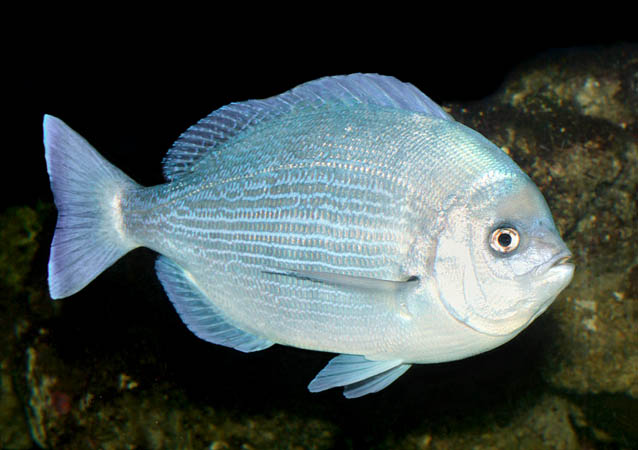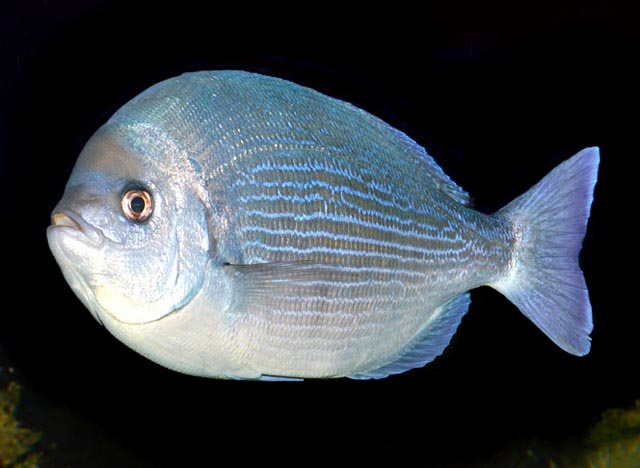Family : Sparidae

Text © Giuseppe Mazza

English translation by Mario Beltramini

Spondyliosoma cantharus goes north up to Scandinavia and south up to Angola © Giuseppe Mazza
The name of the genus comes from the Greek “spondylos” = vertebra, and “soma” = body, due to the unusual cephalic gibbosity of the adult males.
The name of the species “cantharus” is the name the Romans were giving to this fish.
Zoogeography
Present in the entire Mediterranean basin and in the Black Sea, it is a sparid who does not fear the cold. After Gibraltar Strait, we find it, in fact, northward, on the Atlantic coast up to Scandinavia. But it likes also the warm waters, so much that, apart Azores, Madeira, Canaries and Cape Verde Islands, it is always present from Morocco to Angola.
Ecology-Habitat
The juveniles love, like the bream, the Posidonias (Posidonia oceanica) prairies, and the rocky coasts, up to 30 m of depth, but when the are more than 20 cm long, they tend to go down on the detrital bottoms up to about the 300 m.
Morpho-physiology
The black seabream may reach the 60 cm, with a verified weight of 1,22 kg, but the fished specimens measure, as an average, 30 cm.
There are two morphologies, so that, one, when they did not know that they change of sex, they talked of a Cantharus lineatus, of elliptic shape and which recalls the Saupe (Sarpa salpa) also for its golden longitudinal lines, and of a Cantharus orbicularis, of circular shape, stocky, darker, with irregular profile, as if its spinal column should have a problem, hence the new name of the genus.

Changes shape and look depending on age and location, has a night mimetic livery © Giuseppe Mazza
During the night, all black seabreams wear a mimetic pyjama with dark vertical bands.
During the day, in the Atlantic, the males show, on the contrary, some pale vertical bands, which are absent in the Mediterranean, where, on the other hand, during the reproductive period, they turn blue. All this takes place gradually, hence the great confusion of the systematists of the past.
The mouth, of modest size, does not have the incisors typical of the genus Diplodus, but shows many small sharp teeth on both jaws, thicker on the front, where, towards the outside, are placed also some thin and pointed teeth, clearly longer.
The eyes are big, seen the depth it can reach.
The dorsal fin, unique, has 11 spiny rays and 12-13 soft; the anal 3 spiny and 9-11 soft; and the ventral ones have only one spine with 5 unarmed rays. The pectoral ones are long and falciform, whilst the caudal is slightly forked.
Ethology-Reproductive Biology
The Spondyliosoma cantharus is omnivorous: it nourishes of seaweeds and of crustaceans it often looks for while going around in small schools.
It is one of the few species of sparids spawning on the bottom. In spring, every male goes steady with the partner, which it courts digging with the tail some oval small holes in the sand. When the female is ready, it covers them with eggs, more or less stuck to the substratum, immediately fecundated by the male. The vulnerability index of this species is of 37 over 100.
Synonyms
Cantharus cantharus Linnaeus, 1758; Cantharus lineatus Montagu, 1818; Cantharus senegalensis Valenciennes, 1830; Cantharus vulgaris Valenciennes, 1830; Sparus cantharus Linnaeus, 1758; Sparus lineatus Montagu, 1818.
→ For general information about FISH please click here.
→ For general information about BONY FISH please click here
→ For general information about CARTILAGINOUS FISH please click here.
→ To appreciate the BIODIVERSITY of BONY FISH please click here.
→ To appreciate the BIODIVERSITY of CARTILAGINOUS FISH please click here.
